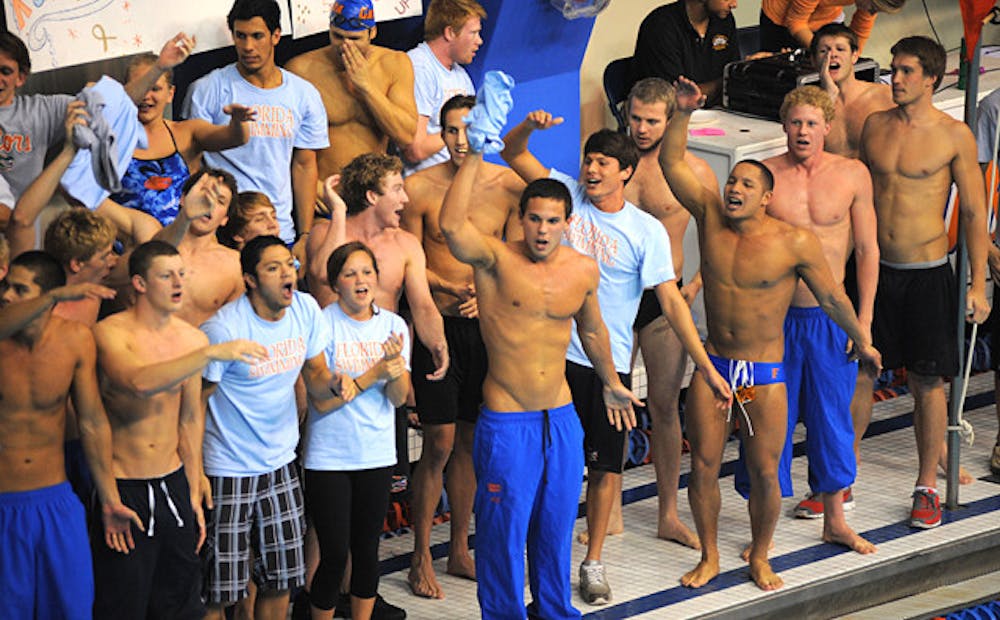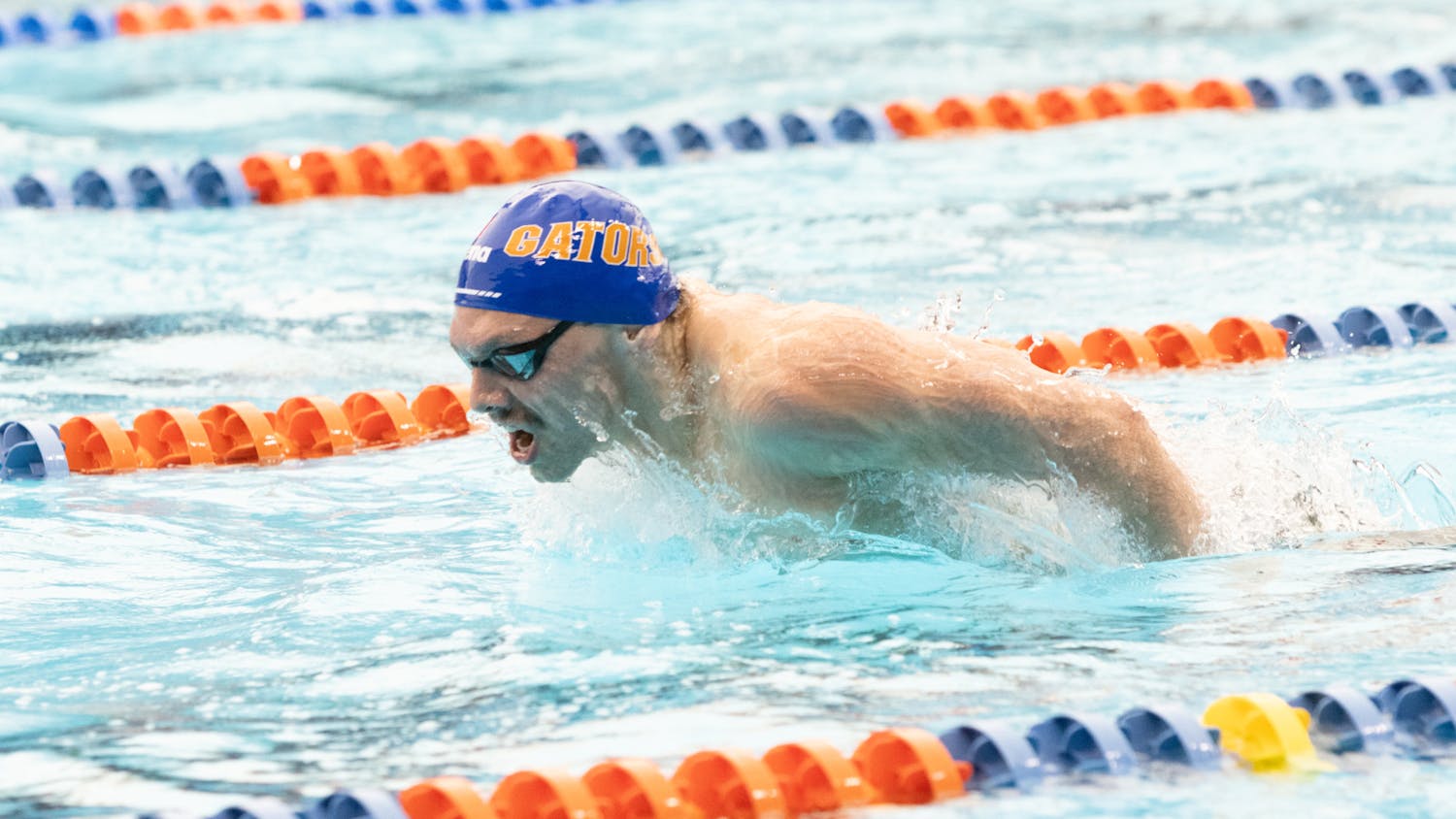They come from all over the world.
Competing internationally for their countries, there are few who are faster in water. Hailing from lands near and far, they all have gathered for the same meet.
Leaping into the water, they dash from wall to wall, water splashing, teammates cheering.
If one reads the names on the heat sheet, they might assume they were at the World Championships or another international event. While the idea wouldn’t be far-fetched, it would be wrong.
As the spectator takes a closer look, the orange and blue gives it away. There’s no United States, Columbia, South Africa or any other country’s flag waving, just those of The Gator Nation.
Nine of the 12 swimmers representing Florida at the NCAA Championships were not born in the U.S. — Brett and Shaune Fraser (Cayman Islands), Balazs Gercsak (Hungary), Roberto Gomez (Venezuela), Marco Loughran (England), Joey Pedraza (Cuba), Omar Pinzon (Colombia), Sebastien Rousseau (South Africa) and Roland Rudolf (Hungary).
“I don’t really think Florida tries to recruit international swimmers,” senior Shaune Fraser said. “I think the success that international swimmers have at Florida makes others want to come here.”
The Melting Pool
Fraser, the defending NCAA champion in the 200-yard freestyle and the 200-yard butterfly, is one of the many UF swimmers who has made an impact for the Gators and his respective country.
Along with being an NCAA record holder and 20-time All-American, Fraser has already competed in two Olympic Games and taken on the role of flag-bearer for his home country of the Cayman Islands.
Among the other eight are a total of six Olympians and 31 All-America honors, and of the seven Gators who were awarded All-Southeastern Conference honors this year, only one of them was born in the U.S. — proving the enormous impact of foreign-born swimmers at UF.
“It’s a combination of Florida’s good reputation for international athletes and, even though they’re foreign athletes, they went to high school in the States,” coach Gregg Troy said.
Of the nine international swimmers competing, Shaune Fraser, Gomez, Pedraza and Pinzon attended high school in the U.S.
After Fraser participated in the 2004 Athens Olympics as a 16-year-old, he moved from the Cayman Islands to the U.S. to attend The Bolles School in Jacksonville.
At the powerhouse swimming school, Fraser became a four-time Florida state champion.
More importantly, Fraser got invaluable training and experience he may not have received had he stayed in the Cayman Islands.
“The swimming facilities weren’t that great in the Cayman Islands and there wasn’t an established coach,” Fraser said. “My dad figured Bolles would be a great place to reach my potential.”
One of the other five international swimmers who differ in high school experience from Fraser is his younger brother Brett.
Unlike Shaune, Brett did not attend Bolles. He stayed in the Cayman Islands until he became a Gator, and like other swimmers who come straight to UF from foreign countries, the younger Fraser faced a difficult challenge.
“Brett had a hard time adjusting to the training regiment,” associate head coach Anthony Nesty said. “The improvements from his freshman year to now are just amazing.”
Culture Shock
International swimmers coming to swim at Florida is nothing new. As a former Gator, Nesty can relate to what both Frasers have gone through as international swimmers.
After competing for Suriname in the 1984 Olympics, Nesty moved to the U.S. to attend Bolles.
Nesty, who won the gold medal in the 100-meter butterfly at the 1988 Seoul Olympics, became a five-time NCAA champion at UF.
“It was a shock to my system for the first four months,” Nesty said. “I went from training 10-12 hours a week at home to training 20-24 hours per week.”
While most of them have been successful transitioning to collegiate swimming, it does take a while for them to become accustomed to the team aspect.
“The American athletes are used to the team concept. The foreigners are used to training in small teams where they’re the best athletes,” Nesty said. “The foreigners go to meets with just a coach and one or two athletes.”
There are no rifts or rivalries amongst the international swimmers or between the international swimmers and American swimmers.
Once the swimmers grasp the team concept, they do more together than just swim in the same pool.
“Swimmers usually hang out with swimmers. They train together, go to meets together and go to the dining hall together,” Nesty said. “Most of them do a good job of being part of the team.”
Learning in America
So, besides for the swimming, why do so many international swimmers come to Florida?
Even though coaches, facilities and prestige weigh in on an athlete’s school decision, the main reason they choose UF is its academics.
In fact, that is why, more often than not, the biggest transition international swimmers have to make is with the increased amount of training and not the cultural barriers.
“They’re very well educated,” Troy said. “That’s what makes international swimmers want to come to the States — to compete and get a good education.”
Whether it’s Rudolf, a seven-time recipient of Hungary’s Outstanding in Academics and Sport award, or Gomez, who picked UF because of its engineering program as well as the swimming, international swimmers are some of the brightest both in and out of the water.
Their success cannot be contained by language barriers or international boundaries, only two lane ropes 25 yards long.





